Black Hat - RHACS Log4Shell Vulnerability Demonstration
In this lab, you demonstrate how to quickly stop workloads with log4shell vulnerabilities from deploying using Red Hat® Advanced Cluster Security for Kubernetes (RHACS). You also learn how to locate workloads with log4shell.
-
Prevent the execution of vulnerable deployments
-
Report and resolve the violation
Ensure a clean environment
Start by ensuring you have a clean lab environment. Run the following command to reset any changes others may have made.
oc delete project log4shell
rm ~/deploy.yaml
ROX_CENTRAL_ADDRESS=$(oc -n stackrox get route central -o jsonpath='{.spec.host}')
POL_ID=$(curl -k -H "Authorization: Bearer $ROX_API_TOKEN" "https://$ROX_CENTRAL_ADDRESS/v1/policies" | jq -r '.policies[] | select(.isDefault|not) | .id')
curl -k -X DELETE -H "Authorization: Bearer $ROX_API_TOKEN" "https://$ROX_CENTRAL_ADDRESS/v1/policies/$POL_ID"Deploy the log4shell infected container image
The next step is to deploy the log4shell laden container image to the OpenShift cluster.
Procedure
-
Start by creating a new project and deploying a vulnerable Log4Shell application.
oc new-project log4shellNow, using project "log4shell" on server "https://api.cluster-fdg9s.fdg9s.sandbox674.opentlc.com:6443".
You can add applications to this project with the 'new-app' command. For example, try:
oc new-app rails-postgresql-example
to build a new example application in Ruby. Or use kubectl to deploy a simple Kubernetes application:
kubectl create deployment hello-node --image=k8s.gcr.io/serve_hostname-
Next, deploy the vulnerable application by creating and applying the following deployment YAML file:
cat << EOF >deploy.yaml
apiVersion: apps/v1
kind: Deployment
metadata:
name: log4shell
namespace: log4shell
spec:
replicas: 1
selector:
matchLabels:
deployment: log4shell
template:
metadata:
labels:
deployment: log4shell
spec:
containers:
- name: log4shell
image: quay.io/rhacs-misc/log4shell:1.0
imagePullPolicy: IfNotPresent
ports:
- containerPort: 8080
protocol: TCP
resources: {}
terminationMessagePath: /dev/termination-log
terminationMessagePolicy: File
restartPolicy: Always
EOF-
Deploy the log4shell deployment into your new project by using the 'oc' CLI
oc create -f ./deploy.yaml[lab-user@bastion ~]$ oc create -f ./deploy.yaml
deployment.apps/log4shell created-
Ensure that the application was deployed without issues.
oc get pods -l deployment=log4shell -A[lab-user@bastion ~]$ oc get pods -l deployment=log4shell -A
NAMESPACE NAME READY STATUS RESTARTS AGE
log4shell log4shell-5d4b665947-grp8d 1/1 Running 0 63s| For the last part of this section, check to make sure that the log4shell vulnerability is in the container with a quick CLI scan using the roxctl CLI |
-
Execute the following command in the terminal to ensure the log4shell vulnerability is present.
roxctl --insecure-skip-tls-verify -e "$ROX_CENTRAL_ADDRESS:443" image scan --image=quay.io/rhacs-misc/log4shell:1.0 --force -o table --severity=CRITICALmisc/log4shell:1.0 --force -o table --severity=CRITICAL
Scan results for image: quay.io/rhacs-misc/log4shell:1.0
(TOTAL-COMPONENTS: 4, TOTAL-VULNERABILITIES: 3, LOW: 0, MODERATE: 0, IMPORTANT: 0, CRITICAL: 3)
----------------------------------------------------------------------------------------------------------------------------------------+
| COMPONENT | VERSION | CVE | SEVERITY | LINK | FIXED VERSION |
----------------------------------------------------------------------------------------------------------------------------------------+
| org.apache.logging.log4j:log4j-core | 2.14.1 | CVE-2021-44228 | CRITICAL | https://nvd.nist.gov/vuln/detail/CVE-2021-44228 | 2.15.0 |
+ + ------------------------------------------------------------------------------------------+
| | | CVE-2021-45046 | CRITICAL | https://nvd.nist.gov/vuln/detail/CVE-2021-45046 | 2.16.0 |
----------------------------------------------------------------------------------------------------------------------------------------+
| spring-beans | 5.3.10 | CVE-2022-22965 | CRITICAL | https://nvd.nist.gov/vuln/detail/CVE-2022-22965 | 5.3.18 |
------------------------------------- ------------------------------------------------------------------------------------------+
| spring-webflux | | CVE-2022-22965 | CRITICAL | https://nvd.nist.gov/vuln/detail/CVE-2022-22965 | 5.3.18 |
------------------------------------- ------------------------------------------------------------------------------------------+
| spring-webmvc | | CVE-2022-22965 | CRITICAL | https://nvd.nist.gov/vuln/detail/CVE-2022-22965 | 5.3.18 |
----------------------------------------------------------------------------------------------------------------------------------------+
WARN: A total of 3 unique vulnerabilities were found in 4 components| You can see that CVE-2021-44228 can be found in the quay.io/rhacs-misc/log4shell:1.0 container image that you just deployed. |
Great job so far!
Red Hat® Advanced Cluster Security (RHACS) web console
Red Hat Advanced Cluster Security for Kubernetes is a Kubernetes-native security platform that equips you to build, deploy, and run cloud-native applications with more security. The solution helps protect containerized Kubernetes workloads in all major clouds and hybrid platforms, including Red Hat OpenShift, Amazon Elastic Kubernetes Service (EKS), Microsoft Azure Kubernetes Service (AKS), and Google Kubernetes Engine (GKE).
Access the RHACS web console.
Procedure
-
Log into the RHACS console at
{acs_route} -
Click the "Advanced" button in your browser
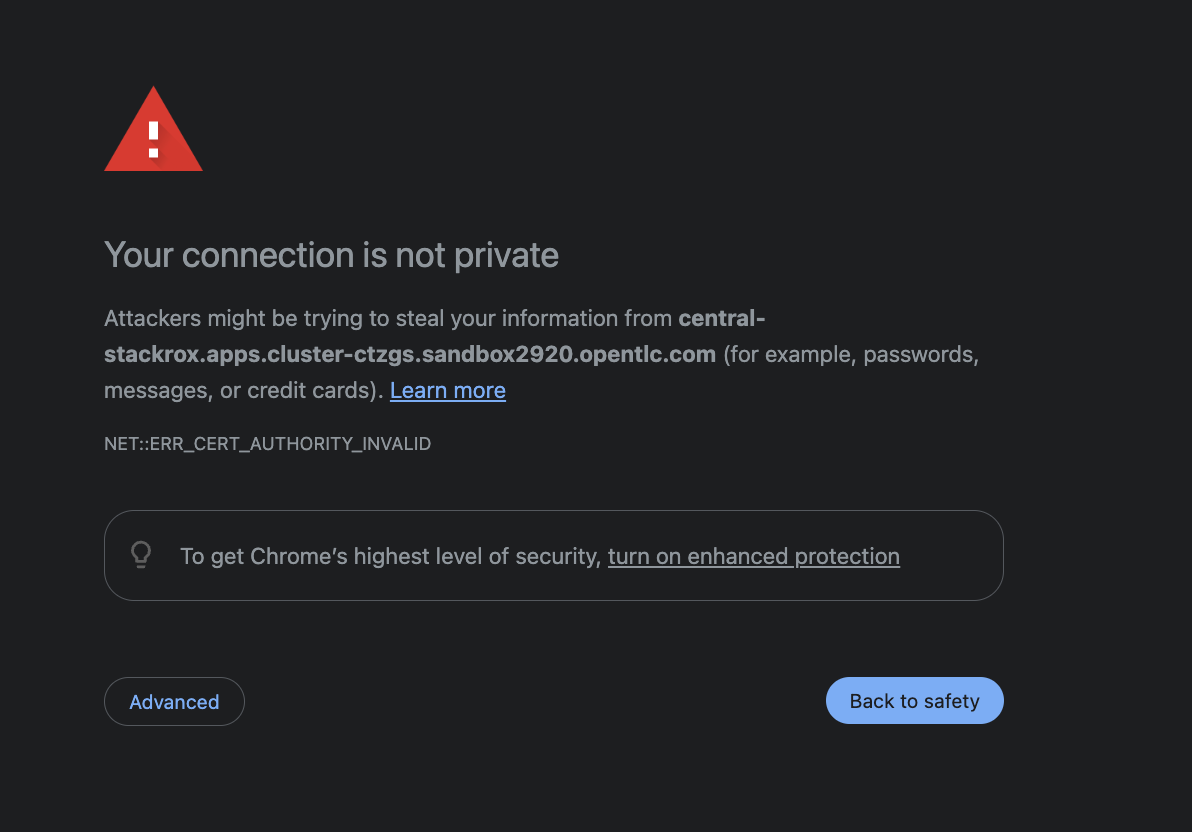
-
Click "Proceed to {acs_route}"
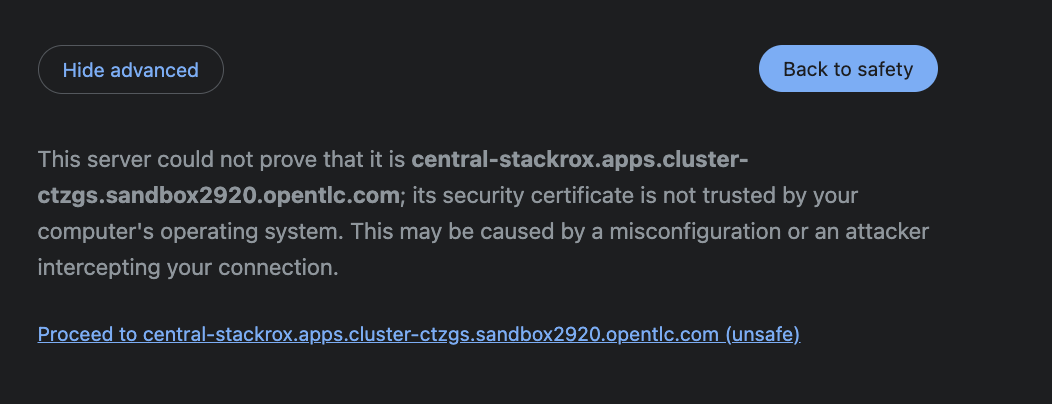
-
Enter the RHACS credentials
RHACS Console Username: |
{acs_portal_username} |
RHACS Console Password: |
{acs_portal_password} |
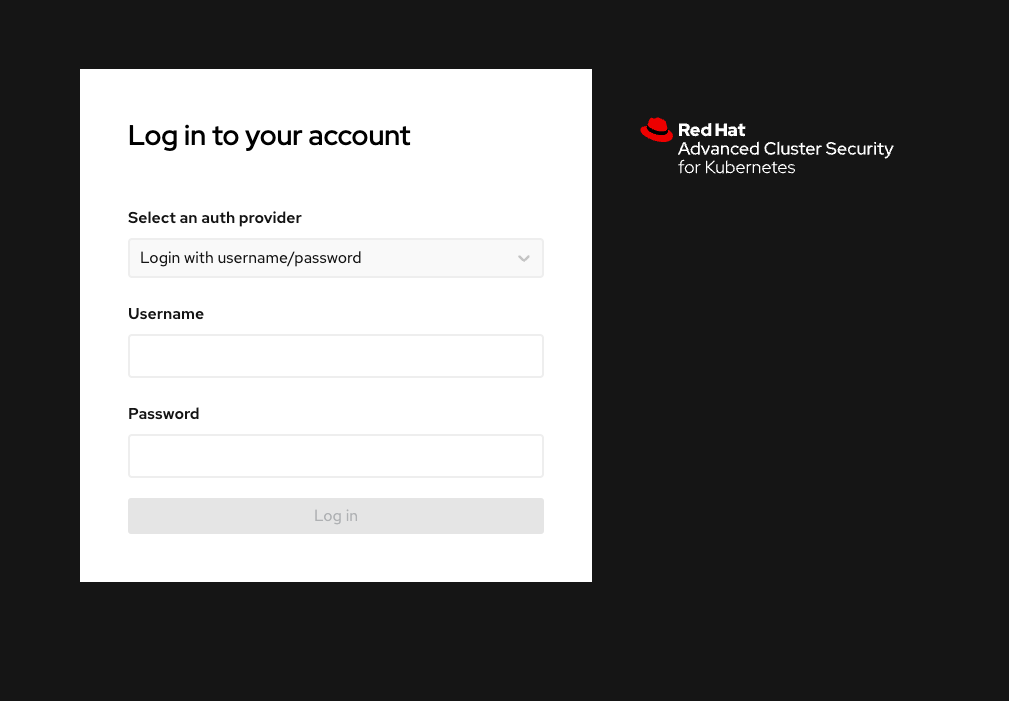
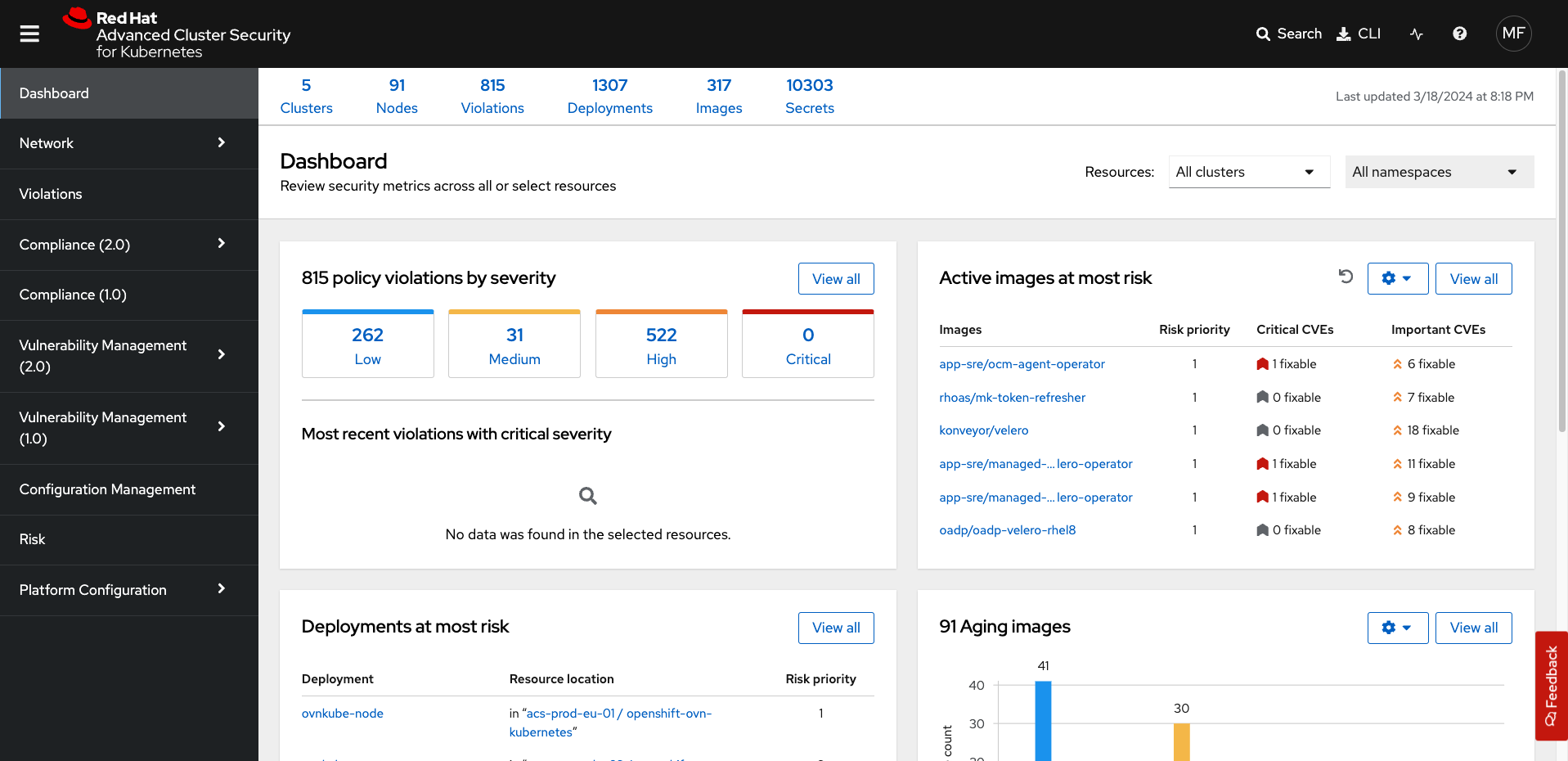
Find the log4shell vulnerability in RHACS dashboard.
The next step is to use the ACS dashboard to locate the Log4shell vulnerability. The following gif will showcase how to find the vulnerability using the exact steps outlined below.
| CVE-2021-44228 & CVE-2021-45046 can both be used to find the log4shell vulnerability in the dashboard. |
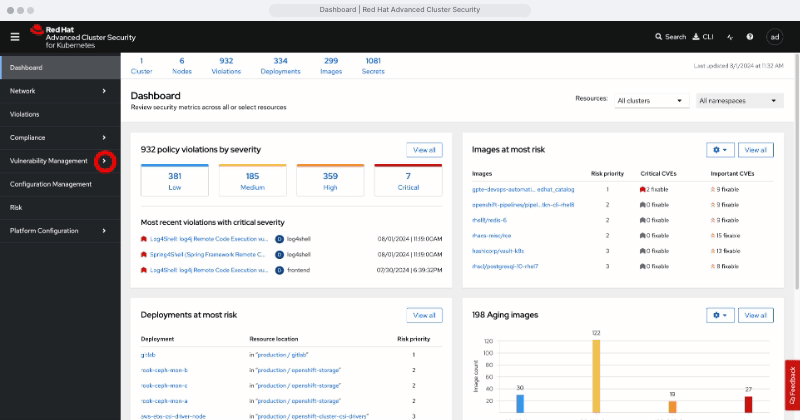
Procedure
-
Click the Vulnerability Management Tab, then click the Workload CVE tab
-
Use the filter dropdown options to ensure that CVE and Name are selected.
-
Use CVE-2021-44228, then click the arrow or hit enter to search for the vulnerability.
-
Click on the 2 Deployments tab to see both the "frontend" and "log4shell" deployments affected by these CVEs.
-
Explore the details of the vulnerabilities present in the "log4shell" container image.
Enforce the default Log4Shell policy
Many default policies ship with RHACS. These policies notify you of violations by default but require their enforcement to enable RHACS to take action and block future deployments or scale pods to zero at runtime.
First, copy the default policy. You can do this by copying the video actions or following the Procedure listed below.
Procedure
-
Click on Platform Configuration → Policy Management
-
Click the search dropdown and select Policy
-
Type in Log4Shell and hit ENTER
-
Clone the Log4Shell: log4j Remote Code Execution vulnerability policy by clicking the three dots to the right of the policy and selecting Clone policy OR by clicking the policy, selecting actions and clicking Clone policy
Great job!
Now, let’s give the policy a new name and enforce it during the build and deploy phases.
Procedure
-
Give the policy an additional identifier for easier searchability. You can also leave the (COPY) label at the end.
-
Click Next
-
Click the Inform and enforce option on the Policy behavior page
-
Scroll down and select the Deploy and Build time enforcement behavior
| This will break container builds AND not allow the deployment of the log4shell vulnerability to your clusters. |
-
Click Next
-
Review the Policy criteria page. This page will outline the CVEs that we are looking to block.
-
Click Next
-
Click next on the Policy scope page. This page allows you to exclude specific clusters, namespaces and deployments. However, we do not want to do this for the log4shell vulnerability.
-
Review the policy and click Save
What he said ^!
Test out your policy!
Finally! It’s time try to redeploy the image that contained the log4shell vulnerability.
oc create -f ~/deploy.yaml| Examine the output and note that the deployment failed to start |
[lab-user@bastion ~]$ oc create -f ~/deploy.yaml
Error from server (Failed currently enforced policies from StackRox): error when creating "/home/lab-user/deploy.yaml": admission webhook "policyeval.stackrox.io" denied the request:
The attempted operation violated 1 enforced policy, described below:
Policy: Log4Shell: log4j Remote Code Execution vulnerability - Enforcement
- Description:
↳ Alert on deployments with images containing the Log4Shell vulnerabilities
(CVE-2021-44228 and CVE-2021-45046). There are flaws in the Java logging library
Apache Log4j in versions from 2.0-beta9 to 2.15.0, excluding 2.12.2.
- Rationale:
↳ These vulnerabilities allows a remote attacker to execute code on the server if
the system logs an attacker-controlled string value with the attacker's JNDI
LDAP server lookup.
- Remediation:
↳ Update the log4j libary to version 2.16.0 (for Java 8 or later), 2.12.2 (for
Java 7) or later. If not possible to upgrade, then remove the JndiLookup class
from the classpath: zip -q -d log4j-core-*.jar
org/apache/logging/log4j/core/lookup/JndiLookup.class
- Violations:
- CVE-2021-44228 (CVSS 10) (severity Critical) found in component 'org.apache.logging.log4j:log4j-core' (version 2.14.1) in container 'log4shell'
- CVE-2021-45046 (CVSS 9) (severity Critical) found in component 'org.apache.logging.log4j:log4j-core' (version 2.14.1) in container 'log4shell'
In case of emergency, add the annotation {"admission.stackrox.io/break-glass": "ticket-1234"} to your deployment with an updated ticket number| This includes the ability to bypass it in an emergency "In case of emergency, add the annotation {"admission.stackrox.io/break-glass": "ticket-1234"} to your deployment with an updated ticket number" |
Review the policy violations
A complete record of the event can be found on the Violations page. Click on it and find the following enforcement notice

Procedure
. Navigate to the Violation page from the left navigation bar.
. Use the Filter Bar to find the Policy: Log4Shell: log4j Remote Code Execution vulnerability and select the policy name.
. Explore the list of the violation events.
Clean up
To prepare the lab for another user, please run the following command.
oc delete project log4shell
rm ~/deploy.yaml
ROX_CENTRAL_ADDRESS=$(oc -n stackrox get route central -o jsonpath='{.spec.host}')
POL_ID=$(curl -k -H "Authorization: Bearer $ROX_API_TOKEN" "https://$ROX_CENTRAL_ADDRESS/v1/policies" | jq -r '.policies[] | select(.isDefault|not) | .id')
curl -k -X DELETE -H "Authorization: Bearer $ROX_API_TOKEN" "https://$ROX_CENTRAL_ADDRESS/v1/policies/$POL_ID"[lab-user@bastion ~]$ oc delete project log4shell
rm ~/deploy.yaml
ROX_CENTRAL_ADDRESS=$(oc -n stackrox get route central -o jsonpath='{.spec.host}')
POL_ID=$(curl -k -H "Authorization: Bearer $ROX_API_TOKEN" "https://$ROX_CENTRAL_ADDRESS/v1/policies" | jq -r '.policies[] | select(.isDefault|not) | .id')
curl -k -X DELETE -H "Authorization: Bearer $ROX_API_TOKEN" "https://$ROX_CENTRAL_ADDRESS/v1/policies/$POL_ID"
project.project.openshift.io "log4shell" deleted
% Total % Received % Xferd Average Speed Time Time Time Current
Dload Upload Total Spent Left Speed
100 31755 0 31755 0 0 258k 0 --:--:-- --:--:-- --:--:-- 258k
{}THANK YOU!


